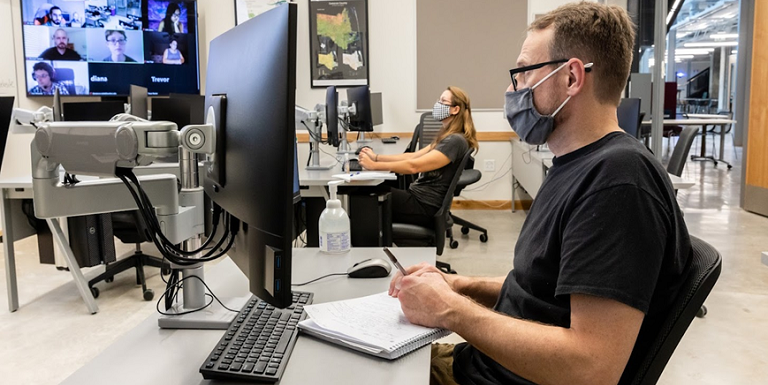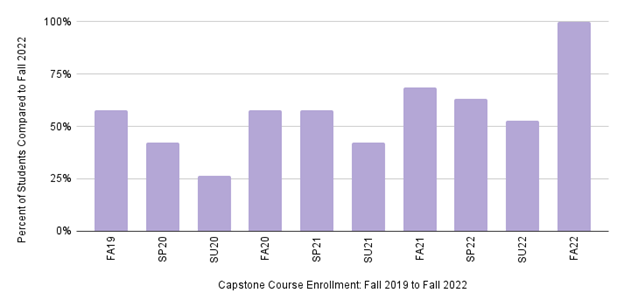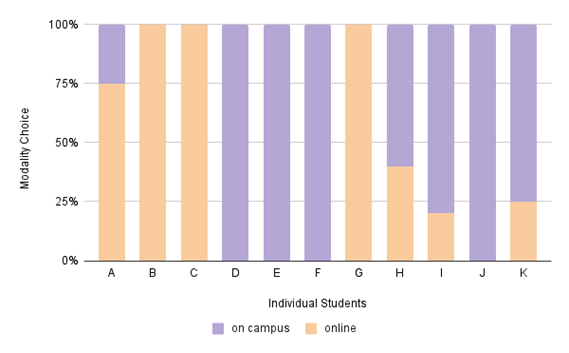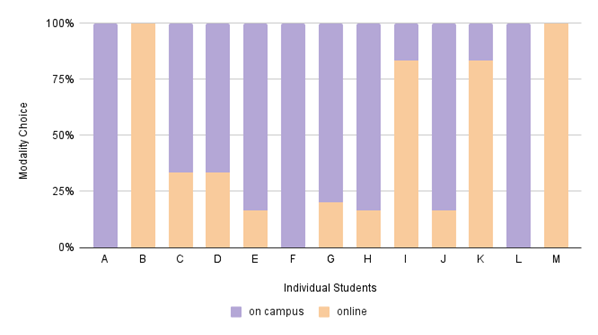Taking Flexibility to the Next Level: One Department’s Experience with HyFlex Implementation

The COVID-19 pandemic and subsequent shift to online learning demonstrated to us that students can not only adapt, but also thrive when provided with diversified and complimentary instructional modes (Ascione, 2021). Inspired by the resiliency of our students, the Geographic Information Systems (GIS) department welcomed students back to Austin Community College (ACC) campuses by piloting a new course modality—Hybrid Flexible, or HyFlex. The HyFlex modality combines online and face-to-face teaching and learning activities in a regularly scheduled class where students are given the choice to attend each session online or on campus.
The addition of the HyFlex mode has allowed students to persist in real time despite personal, institutional, and communal constraints, including those associated with the pandemic and its aftermath. Every student completes the GIS Capstone course, in which they must demonstrate the academic, technical, and professional competencies required to excel as an entry-level GIS professional. Enrollment in this course signifies that students are completing their GIS awards. HyFlex provides students with the flexibility to continue learning in the face of adversity and has resulted in an increase in enrollment in our fall 2022 GIS Capstone course of at least 25 percent compared to previous semesters (see Figure 1).
Figure 1. GIS Capstone Course Historical Enrollment (ACC, 2022)

Putting Flexibility in the Hands of Students
In spring 2021, the GIS department offered its first on-campus course after the shutdown in March 2020, presenting students with an initial opportunity to experience HyFlex. ACC defines HyFlex as a face-to-face, synchronous course section that allows students to select whether to attend virtually or on campus on any given class day based on their current needs. The faculty member is in the classroom at ACC for each class meeting, placing flexibility in the hands of the students.
Since the first HyFlex pilot class, many students have stated that they prefer to attend class on campus due to distractions or a lack of technology at home or to interact with their classmates and enhance their learning experience. However, students also shared that they prefer to occasionally attend class online to accommodate their work schedules or due to a lack of transportation, unforeseen health reason, or familial obligation.
The department designed the class as online with face-to-face attendees rather than the other way around to provide an equitable learning experience for all students. The course websites hosting the curriculum were designed for online asynchronous learning, ensuring that students have access to all of the course materials, regardless of how they choose to attend class. This includes participation activities such as discussion groups and collaborative documents, formative assessments such as self-graded quizzes, and summative assessments such as projects and exams. Course delivery focuses on providing ample student-student, student-instructor, and student-content interactions.
Technology Is Key
As of fall 2022, 100 percent of the face-to-face classes offered by the GIS department are delivered in the HyFlex modality. The classroom is outfitted with high-quality audio and video technology, allowing online and on-campus students to interact with each other. Faculty host a web meeting for remote students and share the projected screen with everyone. Students at home can see and hear their classmates in the classroom through the web meeting, and students in the classroom are able to see and hear their online classmates through the classroom audio/visual technology. Web meeting technology allows for dynamic class interaction through polls, screen share, breakout rooms, reactions, whiteboards, annotation, and remote control.
Flexible Curriculum Design
The GIS Department also implemented competency-based education (CBE) curriculum certified through the Quality Matters (QM) rubric. Collaboration with instructional designers during curriculum redesign enhanced quality assurance and ensured best practices with the understanding that “a well-designed course is more likely to engage learners and positively affect their performance” (Quality Matters, n.d., para. 1). All competencies, topics, and performance criteria are described using Bloom’s Taxonomy, incorporating action words that reflect the cognitive level and skill being taught. Additionally, students are taught to employ the analytical process—question, inform, analyze, evaluate, and present—in solving geospatial problems. This facilitates critical thinking as GIS students combine spatial information and analysis to develop a new, deeper, or changed understanding of the world.
All outcomes and objectives are mapped and aligned with the ACC GIS program-level student learning outcomes and the U.S. Department of Labor’s Geospatial Technology Competency Model. Curriculum mapping and course alignment provide clear, measurable goals with the intention of promoting academic and professional success, encouraging persistence, and supporting recruitment (Nelson-Hurwitz et al., 2022). What students are learning in week five of their first semester, for example, is clearly mapped to the program-level student learning outcomes and industry competencies. This alignment seeks to create a clear path for student learning, graduation, and employment as a GIS professional.
Modality Trends Showcase Flexibility
Attendance records over the past two years show that some ACC GIS students are taking advantage of HyFlex and switching their modality preference, while others choose one modality more consistently. Figure 2 charts student attendance and modality for a GIS course each week of the 2021 fall semester. Approximately 36 percent of the students attended each class meeting on campus, 27 percent attended each class meeting online, and 36 percent switched modalities throughout the semester. Of those students who flexed their modality in Section 001, online attendance ranged from 20 to 75 percent and on-campus attendance ranged from 25 to 80 percent.
Figure 2: Modality Trends by Individual Students, Fall 2021 Section 001 (ACC, 2022)

However, each student is unique, and this is reflected in Figure 3, which charts student attendance and modality for another section of the same GIS course taught on the same day and campus and by the same instructor as the section in Figure 2. For this class, around 27 percent of students attended each class on campus, 15 percent attended each class virtually, and 62 percent switched modality throughout the semester. Of those students who flexed their modality in Section 002, online and on-campus attendance ranged from 17 to 83 percent.
Figure 3: Modality Trends by Individual Students, Fall 2021 Section 002 (ACC, 2022)

So, how do these trends impact overall student success? Thus far, there has been no clear correlation between the grades earned by synchronous students in the GIS department’s HyFlex courses and their modality choices. The main correlation between diminishing grades and modality choice is evident when students choose not to attend class at all. Students who earned below 80 percent in the above sections were absent more frequently than their classmates.
Preparing Students for a Flexible Career
Learning in the ACC GIS program is extended beyond the classroom through formal and informal learning opportunities. Service learning, field trips, guest speakers, industry events, student internships, and student resume and portfolio development are integrated into the program to ensure that students develop and document the professional experiences valued by GIS employers while at ACC. Each semester, a group of students volunteer their GIS skills to benefit the community by teaming up with a local organization. Students conceive, design, implement, and complete a GIS project in collaboration with stakeholders consisting of peers and professionals who provide feedback on their work. This is an invaluable opportunity for students to demonstrate their abilities to future employers. Student projects have been featured in the international publications Food: An Atlas and ESRI Map Book. They’ve also served as the catalyst for organizational initiatives such as assessing the geospatial accuracy of Next Generation 9-1-1 for the Texas Commission on Emergency Communication.
The department also supports students with unique opportunities through the ACC GIS Incubator for Professional Skills (ACC Inc.) in the form of high-value internships. GIS partners with state and local agencies to conduct real-world projects involving mapping and data analysis for critical infrastructure. Some examples include professional partnerships with the Commission on State Emergency Communications, Texas Natural Resources Information System, Texas General Land Office, and ACC’s Facilities and Construction department. The program has funded paid GIS internships valued at over $500,000. Scot Friedman, Geospatial Technology Services Director at Texas General Land Office, said, “You all do an amazing job of teaching and training, and we are always able to recruit outstanding students from ACC for our GIS internship positions.” Almost all student interns earn full-time employment in the GIS industry after gaining real-life industry experience.
Many of the partner employers are represented on ACC’s GIS Advisory Committee, which includes regional and statewide industry leaders who review program-level student learning outcomes and assessment results on a semi-annual basis. Committee members provide feedback on the results and advise the GIS department on adjusting the learning outcomes and curriculum to reflect industry advancements. This helps align what students are learning with the skills desired by employers.
Hooked on HyFlex
In summer 2022, ACC held several HyFlex workshops, facilitated by ACC GIS Department Chair Stephanie Long, for faculty to learn about the GIS department’s experience with HyFlex. Attendees gained insights into online resources to support their own efforts to offer a HyFlex course and assistance with designing their HyFlex course plan. The workshops listed the fundamental principles of HyFlex course design and included discussion about what makes this format different from other instructional modalities.
Participating faculty developed a set of student learning outcomes for at least one HyFlex course they want to pilot in the next academic year and identified existing and necessary content resources. They also planned for the implementation of effective assessment approaches, drafted effective engagement strategies, and developed skills to enhance interaction throughout the course. Discussions took place surrounding the approximate faculty and student workflow changes needed to support the chosen engagement strategies for all participation modes. Factors likely to affect the implementation of HyFlex courses associated with faculty, student, and support systems—technical and administrative—were considered, and faculty made unique plans for evaluating the impact of HyFlex delivery on student participation and achievement as well as meeting strategic and operational organizational goals (Beatty, 2021).
During the workshop, faculty visited a HyFlex classroom on campus to test the HyFlex technologies available at ACC. This allowed faculty who are considering piloting the HyFlex modality not only to compare the online student experience with an on-campus student experience during a HyFlex class meeting, but also to receive hands-on training with the audio/visual technology.
As a result of these workshops, more faculty are piloting the HyFlex modality in their courses across numerous ACC departments and several campuses during the 2022-2023 academic year. The goal is to bring the innovation to scale and to collect important metrics, all while providing students the flexibility to choose the modality that serves their learning style and academic success . . . that day.
References
Ascione, L. (2021). Higher-ed students say they need more flexibility. eCampus News. https://www.ecampusnews.com/2021/08/31/higher-ed-students-say-they-need-more-flexibility
Beatty, Brian. (2021). Hybrid-flexible course design: Implementing student-directed hybrid classes. EdTech Books.
Nelson-Hurwitz, D. C., Tagorda, M., Patil, U., & Kehl, L. (2022). Improving communication of public health bachelor's degree programs through visual curriculum mapping. Frontiers. https://www.frontiersin.org/articles/10.3389/fpubh.2022.770575/full
Quality Matters. (n.d.). Examine course design through the eyes of a learner. https://www.qualitymatters.org/reviews-certifications/course-design-reviews
Lead image: ACC GIS HyFlex classroom with on-campus and remote students (ACC, 2022)
Stephanie Long is Department Chair and Professor, Geographic Information Systems; Sean Moran is Professor, Geographic Information Systems; and Brandon Whatley is Dean, Design, Manufacturing, Construction, and Applied Technologies, at Austin Community College in Austin, Texas.
Opinions expressed in Innovation Showcase are those of the author(s) and do not necessarily reflect those of the League for Innovation in the Community College.









